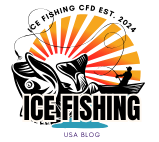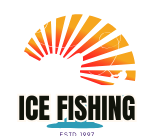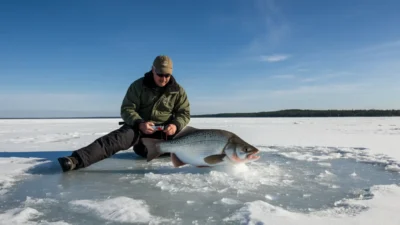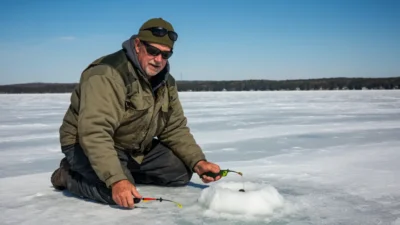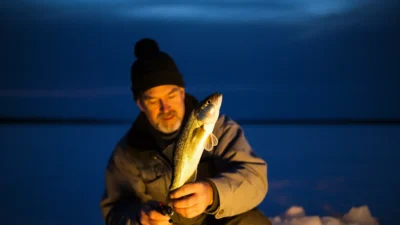Ice Fishing Report Devils Lake North Dakota Fishing Report 2025: Conditions & Outlook
Devils Lake, North Dakota, holds a formidable reputation among anglers across North America. Renowned as the “Perch Capital of the World” and consistently ranked among the top fishing destinations in the United States , it offers a dynamic and productive fishery for multiple species, including walleye, northern pike, and white bass. The lake’s sheer size, currently estimated around 165,000 to 180,000 acres , provides vast opportunities but also presents unique challenges, particularly during seasonal transitions.
Devils Lake is a tale, not simply a lake. It is like a huge playground for fishermen of all ages, covering more than 180,000 acres. This lake offers everything you could possibly want, including prize walleye, huge perch, and aggressive northern pike. The excitement of drilling through the ice, the coziness of a comfortable cabin, and the tales you’ll tell your friends are just as important as the fish. Everything from the most recent 2024 season updates to historical patterns, professional advice, and even some entertaining events like fishing contests and derbies will be covered in this ice fishing report for Devils Lake, North Dakota.
Unlike many fisheries with defined opening and closing dates, North Dakota allows year-round fishing for its primary game species. However, practical access is dictated by weather and ice conditions. Late April represents a critical transition period on Devils Lake, typically marking the end of the viable ice fishing season and the tentative beginnings of open-water opportunities. This report provides a comprehensive assessment of the conditions and fishing outlook for Devils Lake around late April 2025, synthesizing the most recent available data from state agencies and reputable local fishing sources. It aims to offer anglers a clear understanding of ice safety, recent fish activity, effective techniques, access point status, regulations, and the overall health of this legendary fishery during this dynamic time about Ice Fishing Report Devils Lake North Dakota Fishing Report 2025.
Let’s get started or, more accurately, let’s explore!
Executive Summary About Ice Fishing Report Devils Lake North Dakota Fishing Report 2025
The core message for anglers considering Devils Lake in late April 2025 is clear: the ice fishing season has concluded, and any remaining ice is unsafe for travel or fishing. Reports from late March indicated rapidly deteriorating ice conditions, with structural integrity compromised even where thickness remained. Local guides and fishing reports shifted focus decisively towards early open-water shore fishing opportunities by the beginning of April.
Before the ice became unsafe, late-season reports from February and March indicated a steady, though sometimes challenging, bite. Walleye were active, particularly in lower light, often found in shallower areas than mid-winter. Perch fishing was inconsistent, requiring mobility and persistence, with fish primarily located in deeper basins. Northern pike remained a reliable target in shallow, weedy areas. As ice receded, shore access points, notably the Channel A and Pike Playground piers, became functional , offering the first open-water angling possibilities. North Dakota’s year-round fishing season remains in effect, with standard statewide limits applying to Devils Lake for key species like walleye, perch, and pike. Recent fisheries surveys confirm the lake’s robust health, particularly highlighting record walleye populations.
The primary recommendation for late April is to exercise extreme caution regarding any lingering ice. Angling efforts should focus exclusively on shore-based fishing from established, safe access points or early, cautious boat fishing as ramps become clear and conditions permit. Always prioritize safety and adhere strictly to current regulations and access warnings.
👉Related Post: Lake Vermilion Ice Fishing: Your Ultimate Guide
The 2024 Ice Fishing Season: What’s Under the Ice?
Let’s get to the good stuff: the latest ice fishing report for Devils Lake, North Dakota, for 2024. According to the North Dakota Game and Fish Department, this year is looking fantastic for anglers. Here’s what you can expect:
Species | 2024 Statistics |
|---|---|
Walleye | Strong population, many <18″, 15-20″ well above average, >20″ slightly above average |
Northern Pike | Numbers down slightly, most 24-34″, trophy-sized fish available |
Yellow Perch | Normal catchable sizes, more 12″+ “jumbo” perch than usual |
White Bass | Above average, 15-17″ from 2015 hatch, many 13-15″ younger fish |
- Walleye: These fish are doing quite well; there are many tiny ones for simple catches and larger ones (15–20 inches) for more difficult captures. You could even hook a trophy more than 20 inches if you’re fortunate!
- Northern Pike: Although the number of northern pike has decreased compared to previous years, there are still a lot of them in the 24-34 inch range. Particularly in shallow waters, there are some true giants out there.
- Yellow Perch: One of Devils Lake’s main attractions is the perch. There are more “jumbo” perch (12 inches and higher) than normal this year, making for an exceptional capture.
- White Bass: White bass are still quite common; many of the 2015 hatchlings are 15–17 inches in length. The enjoyment is increased by younger ones, around 13 to 15 inches.
2024 is a fantastic year for fishing expeditions, whether of your preference for quantity or quality, according to this ice fishing report for Devils Lake, North Dakota. Because of the lake’s varied fisheries, fishermen of all skill levels may find something to enjoy.
Ice Conditions & Safety Assessment (Late April 2025 Focus)
Understanding the ice conditions leading into late April is crucial for angler safety. While Devils Lake typically boasts a long ice season, sometimes extending into April , the spring thaw inevitably compromises ice integrity.
- Late March Ice Reports: The transition from safe ice to dangerous conditions occurred rapidly in March 2025. Reports from Woodland Resort in late February showed substantial ice thickness, approximately 30 inches in Creel Bay, allowing vehicle traffic on established resort roads. Even then, however, warnings about ice cracks were noted. By March 16th, guide Mike Peluso issued his final ice report for the season, noting the ice was holding up “pretty good considering” temperature fluctuations but signaling his shift to open-water preparation on the Missouri River. A pivotal report from Devilslakefishingreport.com on March 20th provided stark details: while the top 15 inches of ice were described as “still good,” the bottom 6 inches were likened to “crap, like melted butter”. This description signifies honeycombed, structurally weak ice, regardless of overall thickness. The same report predicted “serious degradation” of the ice sheet in the following week. Corroborating this rapid decline, a March 24th report termed that week potentially the “last hurrah” for the ice season. The swift change from reports of thick ice allowing vehicle travel to explicit warnings of structural failure and guides concluding their ice seasons within just a couple of weeks highlights the extreme volatility of late-season ice.
- Analysis of Degradation: The “melted butter” analogy is critical. It indicates that the ice, while potentially thick, has lost its internal strength due to thawing and refreezing cycles, becoming porous and unsafe. Factors like warming air temperatures (forecasts showed temperatures well above freezing ), rain, and wind (mentioned as impacting fishing conditions ) significantly accelerate this degradation process, especially in the stronger sunlight of late March and April.
- Safety Warnings & Late April Viability: Based unequivocally on the late March reports detailing failing ice structure and the typical progression of spring thaw in North Dakota, venturing onto any remaining ice on Devils Lake in late April is extremely dangerous and strongly discouraged. Ice thickness alone is not an indicator of safety during this period. Specific warnings about thin ice near bridges, which often open up sooner due to current, were also noted in earlier reports. The clear shift in focus by local fishing reporters and guides towards shore fishing and open-water opportunities elsewhere serves as a definitive indicator that the safe, viable ice fishing season concluded well before late April.
- Transition Signs: Reports from early April explicitly mentioned open water appearing near bridges and in channels like Channel A. The anticipation of northern coulees opening up was also noted. These are unmistakable signs of the ice-out process being well underway, further confirming the end of safe ice access.
Late Ice Season Fishing Recap (Late March/Early April)
Before deteriorating conditions rendered ice travel unsafe, the late ice period (primarily late February through mid-March 2025) offered variable fishing action for Devils Lake’s primary species.
- Species Activity Summary:
- Walleye: The bite was generally described as steady during this period. A noticeable trend was a shift towards shallower water compared to mid-winter depths, with productive zones reported between 8 to 20 feet, sometimes specifically 8 to 10 feet. Low-light periods around sunrise and sunset remained prime times. Reports indicated good numbers of fish, including healthy populations of eater-sized walleyes (15-18 inches mentioned in summer context ) and the potential for larger fish. However, some anglers reported marking fish, particularly smaller ones, that were hesitant to bite, suggesting variability in feeding activity.
- Perch: The famous Devils Lake perch bite was characterized as inconsistent or “hit or miss” during the late ice season. Anglers often found perch in deeper basin areas, typically 30 feet or deeper (35 feet specifically mentioned) , although some larger “jumbo” perch were occasionally found roaming shallower, even down to 10 feet. Reports emphasized the need to actively search and “work for them,” as schools could be marked but reluctant to bite , with periods where the bite completely shut down. The focus remained on finding catchable-sized perch, often 9 inches or larger , with the ever-present possibility of jumbos.
- Northern Pike: Pike fishing remained consistent and reliable through the late ice period. They were typically found in shallower water, often 5 to 12 feet deep, associated with weed edges or other structure. Tip-ups were a common and effective method. Pike are noted as being abundant and underutilized in Devils Lake.
- White Bass: These aggressive fighters were frequently caught incidentally by anglers targeting perch in deeper water. Devils Lake hosts a very strong white bass population.
- Crappie: While present in Devils Lake and occasionally caught , crappies are generally considered harder to locate consistently than other species. Specific areas like Six Mile Bay, East Devils Lake, and Pelican Lake were mentioned as potential spots. Late-season behavior could involve fish staging in deeper water (28-35 feet) before moving shallow , although they were also caught very shallow (6-7 feet) at times.
The late-ice fishery demonstrated typical seasonal patterns – walleye moving shallower in low light, perch often deeper and more variable, pike reliably shallow. However, the inconsistency reported, especially for perch, underscores the challenges of late ice even when conditions were safe. It reinforces the importance of mobility and persistence, strategies frequently emphasized by local guides who often drill hundreds of holes per day to locate active fish. This dynamic late-ice scenario naturally leads into the transition period, where fish location and behavior patterns shift again with the progression of ice-out.
Effective Techniques: Late Ice & Early Open Water Transition
Angling success during the late ice and early open water transition hinges on adapting techniques to match the changing conditions and fish behavior.
- Reported Late-Ice Tactics (Feb/March):
- Walleye: Vertical presentations dominated. Rattling spoons, particularly Northland Buckshots, and other noisy lures like Clam Blade Spoons or PK Lures were frequently recommended, often tipped with a minnow head to counter short bites. The classic “dead stick” setup – a small jig with a full minnow on a second rod – proved crucial for less aggressive fish. Tip-ups set outside the fish house with similar jig-and-minnow combinations were also highly effective, sometimes out-fishing active jigging during peak low-light bites. Popular lure colors included Wonderbread, Pink, Red, Firetiger, and Gold. Anglers targeted depths ranging from 8 to 20 feet, often focusing on structure like rock piles, flooded timber, sunken roads, or old shorelines. Creel Bay was a frequently mentioned productive area.
- Perch: Finesse presentations were often key, though attraction was still important. Small tungsten jigs (5mm mentioned ) tipped with wax worms, spikes, or minnow heads were standard. Small Swedish Pimples were also effective. Using a slightly larger, louder spoon (like a 1/8 oz rattling spoon) served to call perch in, potentially triggering bites or setting them up for the smaller tungsten offering. Aggressive jigging (“caffeine hands” ) was sometimes needed to activate schools. Effective colors included White, Wonderbread, Gold, and Pink. Perch were primarily targeted in deeper basins (30ft+) but required extensive searching (“drill, drill, drill” ) due to their tendency to roam and inconsistent feeding behavior. Mobility was paramount.
- Pike: Tip-ups baited with smelt were the go-to method. These were typically set in shallow water (5-12 feet) near submerged structure like trees, weed edges, or culverts.
- Crappie: Techniques varied. Aggressive jigging with larger, noisy lures (Rattle Varmints, Jigging Raps, Buckshots) tipped with minnow heads could trigger feeding frenzies in active schools. Conversely, a finesse approach using small tungsten jigs with waxworms or spikes was needed for pickier fish. Depths varied widely based on behavior, from very shallow (6-7 feet ) to deeper staging areas (28-35 feet ).
- Emerging Shore Fishing Tactics (Early April):
- With the ice unsafe, the focus shifted immediately to shore-based angling using standard open-water gear (“long rods” ). Key locations were areas with the first open water and potential current, such as bridges, culverts, and channels like the confirmed-open Channel A.
- Likely effective presentations include casting jigs tipped with minnows or plastics, and potentially shallow-running crankbaits, similar to tactics used in early river fishing. Casting crankbaits like Rapala Eskos towards shallow weeds or structure, a tactic mentioned for summer , might also apply early if accessible from shore.
- Location strategy depends on conditions; if current is low, staying closer to the main basin near bridge areas or Channel A is advised. If precipitation increases flow, fish may travel further up opening coulees.
This distinct shift from vertical ice tactics (jigging spoons, dead sticks, tip-ups) to horizontal shore tactics (casting jigs, plastics, crankbaits) is a necessary adaptation driven by the seasonal change. Anglers must target areas concentrating fish due to current, structure accessible from shore, or early spawning movements.
Devils Lake Access Points: Current Status
Access is paramount during the transition season. With ice unsafe, attention turns to shore fishing locations and the eventual opening of boat ramps.
- Shore Fishing Access: Several locations offer immediate opportunities as ice recedes:
- Channel A Pier: This location was confirmed to be open and in use “since the ice departed” as of early April. Its location as a flowage channel from upper lakes makes it a potential early-season hotspot.
- Pike Playground and Fishing Pier: Located near Walmart, this pier was also confirmed “fully functional” and accessible after ice-out.
- Henegar Landing Pier: While a pier exists here, construction details were still being finalized with completion expected in July 2025. Some access might be possible, but it is not fully operational.
- Bridge Areas: Various bridge locations around the lake were noted as offering limited shore fishing opportunities as open water appears. However, caution is always advised near bridges due to potentially unstable ice conditions persisting longer or changing rapidly.
- Boat Landings/Ramps: Devils Lake features numerous boat landings, many with modern facilities. While widespread boat launching across the entire lake may not be feasible or safe in late April due to potential remaining ice floes or debris, ramps with paved access roads are likely to become accessible as conditions permit. Key landings include :
- Henegar Landing (Paved road, cleaning station, restroom)
- Creel Bay / Lakewood (Paved road, cleaning station, restroom, shelter)
- Schwab Landing / 6 Mile Bay (Paved road, cleaning station, camping, restroom, concession)
- Grahams Island State Park (Paved road, cleaning station, camping, lodging, bait shop, restroom – State Park Pass required)
- Spirit Lake Casino (Paved road, cleaning station, camping, lodging, boat rental, restroom)
- East Bay (Paved road, restroom)
- Estenson Landing (Paved road, trash receptacles)
- Stump Lake Park Landing (Paved road, cleaning station, camping, lodging, restroom, pier)
- Round Lake Bay (Paved road, restroom – Marginal access noted due to shallow cuts)
- Tolna Landing / Stump Lake (Gravel road, cleaning station, restroom)
- Black Tiger Bay (Gravel road, concession, no restroom/docks)
Anglers planning to launch boats should always check the latest conditions. Resources for updates include the North Dakota Game and Fish Department’s “Where to Fish” page , the Devils Lake Tourism website (devilslakend.com) , and reports from local bait shops and guides. The confirmed usability of shore fishing piers like Channel A and Pike Playground provides the most reliable angling access during the unpredictable ice-out phase before widespread boating becomes practical.
- Applicable North Dakota Fishing Regulations (2024-2026)
Anglers must be familiar with North Dakota fishing regulations, which apply year-round on Devils Lake. The current regulations cover the period from April 1, 2024, to March 31, 2026.
- License Requirements: A valid North Dakota fishing license is required for residents and nonresidents aged 16 and older. Specific rules apply to anglers under 16. Licenses are valid from April 1st to March 31st of the following year. Fees vary based on residency and age. Licenses can be purchased online via the NDGF website or at local vendors.
- Season Dates: North Dakota boasts a year-round open season for most game fish, including Walleye, Northern Pike, Yellow Perch, White Bass, and Crappie, on Devils Lake. There are no specific season closures tied to ice formation or ice-out, with the exception of paddlefish snagging in designated areas. While the season is legally open, safe access remains the practical determinant of fishing opportunities, especially during transition periods.
- Devils Lake Daily & Possession Limits: Based on the 2024-2026 regulations guide, standard statewide limits apply to Devils Lake for the key species queried, as no specific exceptions were listed for these fish on this body of water in the provided regulatory text.
Devils Lake Fish Limits (2024-2026 Regulations)
| Species | Daily Limit | Possession Limit | Source |
| Walleye, Sauger, Saugeye | 5 | 10 | |
| Northern Pike | 5 | 10 | |
| Yellow Perch | 20 | 40 | |
| White Bass | 20 | 40 | |
| Crappie | 10 | 20 | |
| Bluegill | 10 | 20 |
Bait Regulations: This area requires careful attention.
- Legal Live Baitfish: Statewide, only fathead minnows, creek chubs, sticklebacks, and white suckers are legal live baitfish. (Rainbow smelt are legal only in the Missouri River system ).
- Other Legal Live Bait: Leeches, frogs, salamanders, and crayfish (native species only) are permitted.
- Terrestrial/Artificial: Live or dead nightcrawlers, waxworms, and manufactured edible baits are legal.
- Critical Restriction: The use of ANY live baitfish (e.g., fathead minnows) is prohibited in water bodies designated as infested with Aquatic Nuisance Species (ANS) or specifically listed as “no live baitfish” lakes. Anglers must consult the current list on the NDGF website (gf.nd.gov) to determine if Devils Lake has any such restrictions before possessing or using live baitfish. This is crucial as ANS designations can change.
- Chumming/Attractants: Using substances to attract fish (chumming) is illegal unless the attractant is directly attached or applied to a legal lure.
- Other Key Rules: Fish must be transported and packaged so that fillets can be readily separated and counted, even when frozen. Fish gifted to others count against the donor’s daily limit. Transporting another person’s fish without the license holder present is generally illegal. Depositing fish parts or litter on ice, water, or shore is prohibited. During the ice fishing season, anglers are permitted to use up to four lines per person. Darkhouse spearfishing for northern pike requires special registration.
The combination of a year-round season and potentially complex bait regulations necessitates diligence. While fishing is always legally permitted, anglers must verify the current ANS status and associated bait restrictions for Devils Lake directly with the ND Game and Fish Department before their trip.
Season Outlook: Ice-Out and Open Water Transition
Late April on Devils Lake marks a definitive shift into the open water season.
- Ice-Out Progression: Given the reports of rapidly degrading ice in late March , significant ice-out was likely underway by early April. Anglers should expect predominantly open water conditions across Devils Lake by late April. While the main ice sheet will be gone, caution is still warranted, as wind can push remaining ice floes into bays or against shorelines, potentially impacting navigation or access in localized areas.
- Fishing Focus Shift: The angling community’s focus clearly transitions from ice fishing (concluded mid-to-late March) to shore fishing as the first access method , followed by boat fishing as ramps become clear and the lake becomes navigable. Late April sits firmly within this early open-water phase.
- Early Open Water Expectations: This period can offer excellent fishing opportunities. Walleye, in particular, are known to utilize shoreline areas, current breaks near bridges or culverts, and newly opening coulees for spawning activities or immediate post-spawn feeding. Warming water in shallow areas attracts baitfish, drawing predators close to shore. Guides often report success targeting shorelines, flooded roads, and rock piles accessible with casting or shallow trolling techniques during spring. Anglers focusing efforts on these transitional areas accessible from shore or via early boat trips may find fish concentrated and active.
- Resources for Ongoing Updates: Conditions can change daily during spring. Anglers seeking the absolute latest information on water levels, ramp accessibility, and fishing reports should continuously monitor official and local sources. Key resources include:
- ND Game and Fish Department (gf.nd.gov)
- Devils Lake Tourism/CVB (devilslakend.com)
- Devilslakefishingreport.com
- Mike Peluso Outdoors
- Woodland Resort Fishing Blog
- Outdoor News (subscription may be required)
Devils Lake Fishery Health Snapshot
Devils Lake maintains its status as a premier North American fishery due to its exceptional productivity and robust fish populations, consistently monitored by the North Dakota Game and Fish Department (NDGF).
- Overall Status: NDGF surveys utilizing standardized gill netting methods provide valuable insights into population trends and health. Recent years have shown particularly strong numbers for key species.
- Walleye: The walleye population is exceptionally strong. Surveys in 2021 and 2022 recorded record or near-record numbers of walleyes per net, significantly above the long-term average. The 2022 survey yielded 35.3 walleyes per net, compared to a 31-year average of 21.5. Critically, the numbers of preferred “keeper” sized fish (15-20 inches) were double the average in 2022, and the abundance of smaller fish (10-15 inches) was also well above average, indicating excellent recruitment and a bright future for the fishery. The 2024 survey showed a slight decrease to 22.6 walleyes per net but remained above the long-term average. The population is sustained by both natural reproduction, which can be significant in high-water years , and consistent stocking efforts by NDGF.
- Yellow Perch: Devils Lake’s fame as the “Perch Capital” persists, though angler reports sometimes note inconsistency in the bite. NDGF surveys confirm healthy populations with good size structure. Netting results showed above-average numbers in 2021 (18.3 per net vs. 11.5 average) and 2022 (15.3 per net vs. 12 average). The 2024 survey recorded 8.8 perch per net. While lower than the previous two years, this still indicates a solid population base. Surveys highlight good numbers of perch in the desirable 10-12 inch range. The slight dip in the 2024 net catch compared to 2021/2022 highs may align with angler experiences of variability, suggesting perch populations might exhibit more cyclical fluctuations or be more challenging to consistently locate and catch than walleye.
- Northern Pike: Pike are abundant and often reach impressive sizes. Surveys consistently show strong numbers, with most fish falling between 24-32 inches or 21-34 inches. The 2024 survey found an average length of 26.5 inches and an average weight of 4.5 pounds. Fisheries biologists consistently note that pike are an underutilized resource in Devils Lake, encouraging anglers to harvest them.
- White Bass: This species thrives in Devils Lake, with populations often registering above average in surveys. Recent years have shown particularly strong numbers of large white bass exceeding 15 inches. The 2024 survey indicated an average size of 13.4 inches and 1.4 pounds.
- Crappie: While not as numerically dominant in surveys as the other primary game fish, black crappie are present and included in statewide regulations , offering an additional angling opportunity.
Devils Lake Fish Population Survey Highlights (2024 NDGF Gill Net)
| Species | Fish Per Net | Avg Length (in) | Avg Weight (lbs) | Notes | Source |
| Walleye | 22.6 | 14.0 | 1.1 | Very strong population; high numbers in recent years | |
| Yellow Perch | 8.8 | 9.0 | 0.5 | Good size structure; catch rates lower than 2021/22 | |
| White Bass | 5.3 | 13.4 | 1.4 | Strong population with good average size | |
| Northern Pike | 2.7 | 26.5 | 4.5 | Abundant, large average size; considered underutilized |
This survey data paints a picture of a remarkably healthy and diverse fishery, capable of providing outstanding angling experiences year-round, conditions permitting.
- Key Local Resources
Anglers planning a trip to Devils Lake, especially during transition periods, benefit from utilizing a range of resources for the most current information.
- Official Information:
- North Dakota Game and Fish Department (NDGF): The primary source for regulations, licensing, fish stocking reports, official lake access maps (including boating access guides for Devils Lake Basin ), Aquatic Nuisance Species (ANS) updates and restrictions, and fish survey data. Website: gf.nd.gov.
- Tourism & General Information:
- Devils Lake Tourism / Convention & Visitors Bureau (CVB): Excellent resource for aggregated local information, including fishing reports, guide service listings, lodging options, bait shop locations, access point details, and community event information. Website: devilslakend.com.
- North Dakota Tourism: Provides broader state context, highlights key destinations like Devils Lake, and features blogs and articles. Website: ndtourism.com.
- Local Fishing Reports: Often provide the most timely, on-the-ice/water updates on conditions and biting patterns.
- Devilslakefishingreport.com (Travis E.): Frequent reports covering ice conditions, fish activity, and techniques.
- Mike Peluso Outdoors: Regular reports, particularly valuable for tracking the shift between ice and open water focus.
- Woodland Resort Fishing Blog: Resort-specific reports, often focusing on Creel Bay conditions and catches.
- Ed’s Bait Shop: Local bait shop often providing fishing reports.
- Outdoor News: Publishes ND fishing reports, though some content may require a subscription.
- AnglingBuzz: Often features reports from prominent Devils Lake guides like Jason Mitchell and the Perch Patrol.
- Guide Services: Invaluable for newcomers or during challenging conditions. Guides possess intimate knowledge of the lake, current conditions, and necessary equipment (including tracked vehicles for difficult snow/ice).
- Perch Patrol Guide Service (incorporating former Mitchell’s Guide Service): A large, well-known operation offering year-round guided trips.
- Woodland Resort Guides: Associated with the resort, offering packages.
- Numerous other independent guides are listed on the Devils Lake Tourism website. Hiring a guide is often recommended, especially for first-time visitors or when mobility is key.
- Resorts/Lodging: Many area accommodations cater specifically to anglers.
- Woodland Resort: Full-service resort offering lodging, guided trips (Perch Patrol), boat rentals, bait shop, restaurant, and fish cleaning.
- Haybale Heights Campground & Resort: Offers cabins, campsites, guided fishing, boat ramp, and fish cleaning on the east side.
- Spirit Lake Casino & Resort: Provides lodging, camping, boat ramp, boat rentals, and fish cleaning.
- Numerous hotels in the city of Devils Lake also offer angler-friendly amenities like fish cleaning stations.
Utilizing a combination of these resources – official regulations from NDGF, aggregated local information from DevilsLakeND, and timely condition reports from local websites and guides – provides anglers with the most comprehensive and up-to-date understanding needed for a safe and successful trip to Devils Lake.
The Ultimate Guide to Fish Catching
Are you prepared to catch some fish? Without some professional advice, this ice fishing report for Devils Lake, North Dakota, wouldn’t be complete. Here are some tips from Hotspot Outdoors on how to catch the big ones:
Walleye: Use live bait rigs topped with minnows or jigging spoons to catch walleye. Keep an eye out for structures such as weed borders, flooded roadways, or rock heaps. Keep moving since walleye might be found in deeper seas or shallow bays. Forty-five minutes after dawn and before nightfall are the best times.
Northern Pike: Action is what Northern Pike are all about! Use loud baits like Rattle Spoons or set out tip-ups with big minnows. Particularly in areas like Haybale Heights, bays and weed margins are ideal locations. To attract northern pike and create commotion, rip the bait violently.
Jumbo Perch: Use 1/4 to 3/8 ounce Buckshot Rattles Spoons topped with entire minnows for jumbo perch. Fish close to drop-offs, deep reef sides, or submerged trees. Being mobile is essential; drill more holes and keep going until you locate them.
General Advice: Prioritize safety! Ice conditions might change, so always check them. To locate hot locations, use a GPS or hire a fishing guide. Sometimes the fish take their time, so be patient, pack food, and wear layers.
In conclusion, your journey is waiting for you.
This Devils Lake, North Dakota, ice fishing report is your roadmap to a fantastic winter excursion. Devils Lake is an angler’s paradise with its amazing fish, lively community, and activities like fishing derbies and competitions. This lake has everything, whether you’re hunting giant perch, fighting northern pike, or just taking in the winter splendor.
For an unforgettable ice fishing experience, gather your warmest clothing, book a fishing guide, and go to Devils Lake. Go create some memories the fish are waiting and the ice is beckoning!
